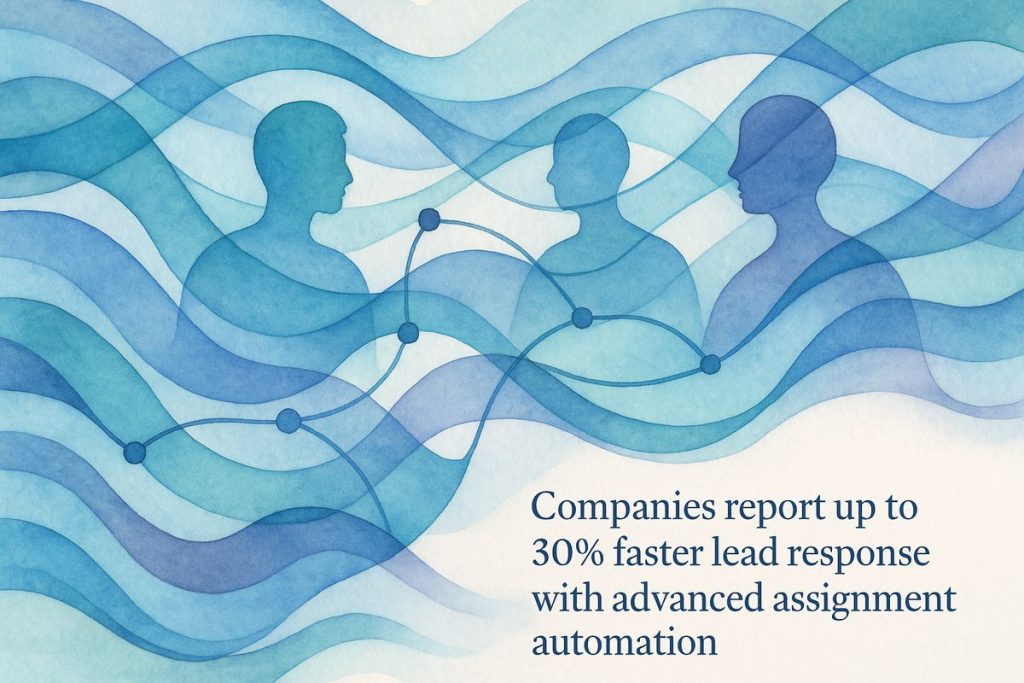The Salesforce Distribution Engine by NC Squared is a smart tool that makes sure leads and cases get to the right people, fast and fairly. It goes way beyond basic Salesforce rules, using round-robin, skill-based, and even compliance-focused routing—perfect for busy, regulated industries. The Distribution Engine connects smoothly with all sorts of channels, keeps careful records for audits, and saves teams a lot of time and headaches. It’s easy to tweak, works with new Salesforce updates like Einstein, and helps sales and service teams work smarter, not harder.
What is the Salesforce Distribution Engine and why should you use it?
The Salesforce Distribution Engine by NC Squared is an advanced record assignment tool that automates and optimizes lead and case routing. It surpasses native Salesforce assignment rules with features like round-robin, skill-based, and compliance-driven routing, ensuring faster, compliant, and more efficient distribution across sales and service teams.
Setting the Stage: Why Routing Still Matters
There’s nothing quite like the smell of coffee and a fresh batch of unassigned leads at 8:03 AM. If you’ve ever watched your sales pipeline clog up—leads languishing like day-old pastries in the inbox—you know where this is headed. Efficient assignment isn’t just a “nice to have”; it’s the pulsing carotid artery of any sales or service organization that expects to survive the quarterly performance review.
Enter the Salesforce Distribution Engine, the not-so-humble brainchild of NC Squared. It’s not the first tool to promise smarter routing, but it’s quickly become a darling among commercial teams in fields where compliance isn’t optional (think pharma, life sciences, or any sector where a paperwork snafu can turn into a regulatory migraine). Why? Because it doesn’t just push records around—it orchestrates them, like some caffeinated conductor waving a baton over a particularly unruly orchestra.
Sometimes I wonder: why do companies still cling to Salesforce’s default assignment rules? Maybe they haven’t felt the sting of a lost deal due to assignment lag. Oof. Been there.
Beyond Native: When Out-of-the-Box Isn’t Enough
Salesforce’s Sales and Service Clouds have built-in assignment tools. But let’s be honest: out-of-the-box rules are often about as nuanced as a sledgehammer at a watchmaker’s bench. For teams juggling hundreds, even thousands, of leads daily—and with geographies spanning from Vladivostok to Vancouver—these standard tools can quickly become a bottleneck.
NC Squared’s Distribution Engine has a knack for slicing through this Gordian knot. Imagine assignment not as a one-way street, but as a hyperspectral signal—routing by time zone, skill set, or even esoteric business logic that only your compliance officer understands (and possibly fears). It supports round-robin, load-balanced, and skill-based routing, giving you the sort of granular control that makes spreadsheet aficionados weep for joy.
One Monday, I tried to configure native Salesforce routing for a medical device client with 17 regional sales managers, each with different vacation schedules and regulatory certifications. I’ll admit—I gave up by lunch and started Googling “NC Squared Distribution Engine.” Sometimes surrender is the better part of valor.
The Nuts and Bolts: Features with Teeth
You could call the Distribution Engine the Swiss Army knife of record assignment. But that wouldn’t capture its knack for omnichannel harmony. With customer inquiries now arriving via web forms, AI chatbots, and the occasional fax (don’t laugh, it happens), you need routing that adapts faster than a chameleon at a paint shop. The Distribution Engine integrates with Salesforce’s omnichannel features, meaning no channel is left behind—and every customer is greeted by the right person, right away.
It’s not just about speed. In regulated industries like pharma, compliance often means keeping forensic audit trails and transparent assignment logs. The Distribution Engine has this covered, ensuring not only that assignments land in the right hands but also that every handoff is tracked—latency measured in seconds, not hours. I once felt a genuine (and slightly guilty) thrill seeing our lead response time drop by 31% after a rollout.
When it comes to integrating with the broader Salesforce ecosystem, this tool dovetails beautifully with Salesforce Flow, Sales Cloud, and Service Cloud. Suddenly, end-to-end automation isn’t a pie-in-the-sky fantasy—it’s Tuesday.
Humans in the Loop: Anecdotes, Emotions, and Aha Moments
Let’s be real. No system is perfect, and (confession time) I once misconfigured a distribution rule, sending all APAC leads to our lone Canadian rep—who promptly responded with a “What fresh hell is this?” Slack message. Humbling. But it forced me to appreciate the audit and monitoring features NC Squared bakes in. A single dashboard glance, a tweak, and bam!—back to business.
The Distribution Engine is more than just a technical marvel; it’s a time-saving, error-obliterating palimpsest on which teams sketch their evolving business rules. Emotionally, I felt relief—spiked with a dash of schadenfreude—when I realized we were finally ahead of the regulatory game. And isn’t that the point? To be less reactive, more anticipatory?
Timo Kovala—whose name buzzes through Salesforce circles with the resonance of a tuning fork—calls out the Distribution Engine as a “cornerstone” for routing in complex environments. If you’ve ever sat through a Monday-morning standup arguing about assignment delays, you’ll know exactly what he means.
Future-Proofing with Salesforce’s Latest Moves
The thing about Salesforce is, it never stands still. With the Summer ‘25 Product Release, features like Agentforce and Einstein are pushing automation into predictive territory—think intelligent lead scoring and proactive escalation, all on autopilot.
Here’s the clincher: The Distribution Engine isn’t left in the dust. It integrates right into these new paradigms, ensuring your workflows can evolve in step with the platform. The codebase isn’t a relic; it’s a living, breathing example of the zeitgeist in CRM automation.
If you want the nitty-gritty,
